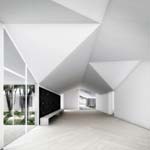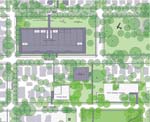
|

|
|
Home Site Search Contact Us Subscribe
|
|
|
Drawing an Elegant Conclusion: Menil Drawing Institute by Johnston Marklee Houston: In the somewhat arbitrary hierarchy of fine art media, where painting is king, drawing is often considered less valuable. The new MDI elevates the medium by providing a distinguished, respectful home. By Julie D. Taylor, Hon. AIA/LA April 1, 2014 Designed to rest lightly on the Houston land, the new Menil Drawing Institute (MDI) will bring an intimate scale to the 10-block campus of The Menil Collection. Selected from an invited competition, Los Angeles-based Johnston Marklee has produced an elegant building that respects existing edifices by AIA Gold Medal winners Renzo Piano, Hon. FAIA, and Philip Johnson, FAIA, while carving out a place of its own.
MDI was founded in 2008, but had been working out of the main museum since then. The Johnston Marklee project will be the first building created after the museum undertook a master planning process with David Chipperfield Architects in 2009. Projected groundbreaking for the 30,150-square-foot building is for early 2015, with expected completion of the $40-million project in 2017.
Sharon Johnston, AIA, points to the Menil’s home, designed by Johnson in 1949, as “the DNA of the project,” emphasizing the domestic scale and transparent connection with nature in the new building. The architects refer to MDI’s elements as the “porch,” “courtyard,” and “living room” set within a “neighborhood,” conveying the intimate feeling intended for visitors and staff. Intimacy is key in the appreciation of drawings, as they demand viewer concentration that is different from how large Abstract Expressionist paintings – such as those seen in the Rothko Chapel (Johnson, 1971), also on the premises – are regarded.
Visual metaphors of drawing exist, but they never become cloying. A white reinforced steel-plate roof (think: blank sheet of paper) unifies the series of buildings and courtyards in its elegant, eight-inch folding profile. Walls beneath are either glass or clad in wood – wide cedar planks that bring to mind swaths of charcoal across pristine paper. “Unconventional use of conventional elements interests us,” Johnston explains. Using wide planks on the small building plays off the small-scale wood slats on Piano’s main museum structure from 1987.
Glass walls are necessary to the transparency aspect of the project, yet prove challenging for light distribution that won’t harm drawings. Creating inviting enclosures for exhibition and study that were not dreary and dark is another challenge the architects faced. The solution was the shifting scale of spaces that balance transparency and solidity. The journey from inside gallery to landscaped courtyard to glass view corridor modulates the sequence of spaces that are meant to blend art, architecture, and nature. The building maintains the desired balance between the private nature of drawing study and the public mission of the organization.
Promoted as “the first freestanding facility in the United States created especially for the exhibition, study, storage, and conservation of modern and contemporary drawings,” MDI will join the new Energy House (central plant) also designed by Johnston Marklee. Landscape architecture firm Michael Van Valkenburgh Associates is designing an expansive, sustainable landscape to tie the elements together.
In the somewhat arbitrary hierarchy of fine art media, where painting is king, drawing is often considered only preparatory or less valuable, though many are basically paintings on paper. MDI – through the work of Johnston Marklee – elevates the medium by providing a distinguished, respectful home.
West Coast correspondent for ArchNewsNow.com, Julie D. Taylor, Hon. AIA/LA, is the principal of Taylor & Company, a public relations and marketing services firm for architects, and the editor of the Society of Architectural Historians/SCC News.
Also by Taylor:
Monterey
Design Conference: 1 Mile of Beach. 3 Days. 20 Speakers. 50 Hours. 100s of
Conversations. 1,000s of Ideas
The
Blob That Could Eat Los Angeles
Overdrive:
L.A.'s Future is Present in its Past
Report from IDSA 06: Elements of Change (and architecture)
|
(click on pictures to enlarge)  Courtesy of Johnston Marklee/The Menil Collection The Menil Drawing Institute, south façade  Courtesy of Johnston Marklee/The Menil Collection Partial view of the Living Room and Scholars’ Cloister  Courtesy of Johnston Marklee/The Menil Collection Menil Drawing Institute at dusk, looking past the west entrance courtyard  Courtesy of Johnston Marklee/The Menil Collection The west courtyard of the Menil Drawing Institute  Courtesy of Johnston Marklee/The Menil Collection The Menil Drawing Institute, west façade as seen from the Energy House.  Courtesy of Johnston Marklee/The Menil Collection Site plan for the Menil Drawing Institute and new Energy House in relation to the main museum building and Cy Twombly Gallery |
© 2014 ArchNewsNow.com